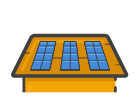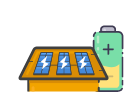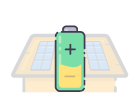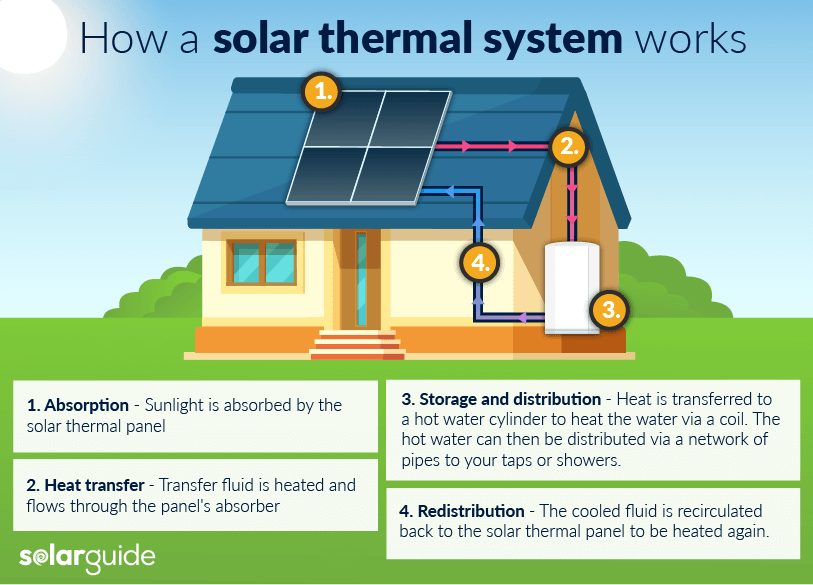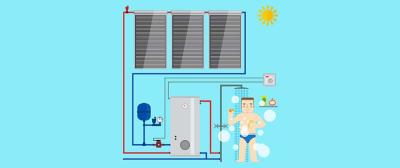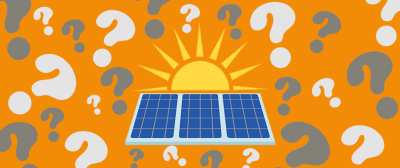Solar Thermal Panels in The UK: Costs, Installation & Grants
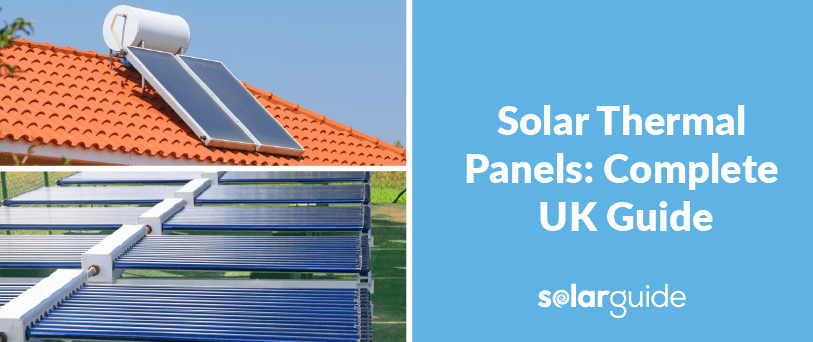
Did you know that solar thermal panels were the first solar energy product to be commercialised in the UK? Solar thermal energy is a great, and largely unexploited option if you want to use renewable energy from the sun to provide hot water to your home. Thermal solar is not to be confused with solar photovoltaics (PV) which focuses on generating electricity to power appliances.
In this article, we’ll break down the most important things you need to know before getting solar thermal panels in the UK. From how they work and their advantages/disadvantages to the trick to securing the best deals.
Ready to get a solar thermal system and reap money and energy-saving benefits? A solar professional can offer you their expertise on the best panels for your home and offer you a market competitive quote. It all starts with getting in contact with several reliable solar professionals near you so that you can compare quotes. Something that can take hours when done on your own.
Don’t worry, with Solar Guide and partner solar experts, the thermal solar panels process is painless, quick, and without any second-guessing (and without costs either!). All you need to do is fill in our 1 minute contact form and in return, you get up to 4 quotes from different installers all for free and without any obligation to accept.
Get started by clicking the link below!
Get Free Solar Thermal Panel Quotes: Get quotes and compare prices.
What are solar thermal panels?
When it comes to solar panels, there are 2 main types: solar thermal vs photovoltaic panels. A solar thermal water heating panel, also known as a solar water heating collector, is a device that absorbs energy from sunlight and transfers it to heat water for your taps, showers, and baths.
In fact, a solar thermal heating system can provide up to 60% of the average annual hot water demand for a UK household. Their output will peak during the summer when the days are longer and there is more sunlight.
Large solar thermal systems can even supplement conventional heating systems. However, it’s most effective to do this during the summer when demand is low due to their lower capacity for solar thermal hot water.
A solar thermal panel, just like any other solar panel can be mounted onto your home’s roof or on a frame in your garden. Generally, you’ll be looking to place it in a space that can fit several panels.
How does a solar thermal system work?
“How does a solar thermal system work?” can be a complex question. To keep things simple, solar thermal panels typically work together as a single solar thermal system connected to a hot water storage tank. Solar systems work on the principle that dark colours absorb heat more efficiently. Your thermal system will convert the absorbed sunlight into heat energy to give you hot water stored in your hot water cylinder. In general, the step-by-step process is as follows:
- Absorption – Sunlight is absorbed by the solar thermal panel, which is designed to capture as much sunlight as possible
- Heat transfer – The absorbed sunlight heats up a heat transfer fluid that flows through the panel’s absorber
- Storage and distribution – The heated fluid is then transferred to a heat exchanger, which transfers the heat to a hot water cylinder to heat the water via a coil. The hot water can then be distributed via a network of pipes to your taps or showers.
- Redistribution – The cooled fluid is recirculated back to the solar thermal panel to be heated again.
The main challenge with solar thermal panels is transferring the heat to water without losing efficiency. How your specific solar thermal hot water system works depends on what type you have. There are 2 main types of thermal solar panels available on the market:
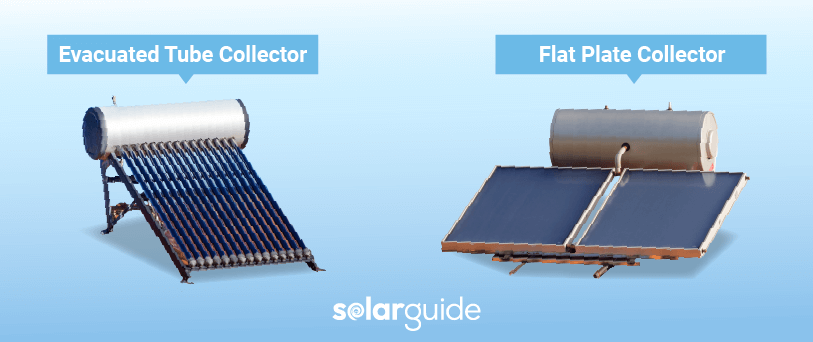
- Flat plate collectors – This is the most popular solar thermal type in the UK. It has a similar external appearance to a solar PV panel as it’s enclosed with a transparent cover that allows for solar radiation to go through. Inside lies a thin metal sheet with a selective coating that acts as a solar absorber plate. In the absorber, fluid is pumped through the absorber tubes to transfer heat from the absorber to heat water in a storage tank. Around the flat absorber plate is a layer of insulation to reduce heat loss.
- Evacuated tube collectors – Despite being less popular, evacuated tube collectors are actually capable of achieving higher efficiencies and operational temperatures when compared to flat plate collectors. As the name suggests, this type is made up of several parallel glass tubes in which heat-transfer liquid flows through. The fluid evaporates and rises to a condenser at the top of the heat pipe which heats water. Each tube is evacuated of air to form a vacuum so that conduction and convection heat loss is minimised.
Differences of solar thermal vs solar photovoltaics
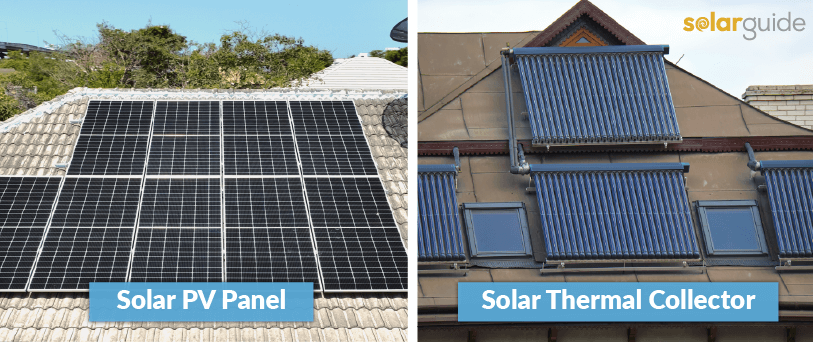
Solar energy technologies have advanced significantly in recent decades, with 2 main technologies taking the spotlight: solar thermal systems and solar photovoltaic (PV) panels. They’re often confused with each because they both harness the sun’s radiant energy, yet they differ significantly because they offer fundamentally different functions.
In this section, we compare solar thermal panels vs photovoltaic panels, shedding light on their applications, efficiency, costs, and more. Understanding these differences can help you choose the right solar option for your needs and goals.
| Factor | Solar Thermal | Solar PV |
|---|---|---|
| Type of energy produced | Heat energy | Electrical energy |
| Primary use | Water heating, space heating | Powering homes/businesses |
| Average lifespan | 20-30 years | 25-30 years |
| Energy storage | Often combined with thermal storage systems to store excess heat energy or hot water for later use | Typically paired with battery storage systems to store excess electricity |
| Maintenance | Regular cleaning and maintenance required | |
| Cost* | £3,000 – £7,000 | £5,000 – £11,500 |
| Grant availability | VAT Reduction, Home Upgrade Grant | VAT Reduction, Home Upgrade Grant, ECO4, Smart Export Guarantee (SEG) |
| Grid interaction | Limited ability to interact with the electric grid directly | Can feed excess electricity into the grid and participate in net metering programs |
*Data from the Department for Business, Energy & Industrial Strategy (2023)
While both solar panel types are used in the UK, solar PV panels are more commonly installed. This is likely due to solar PV systems generating electricity that is very versatile for domestic and commercial uses. However, solar PV can cost a lot more so it’s important to know what size system you will need. To learn more about this you can visit our guide titled “How many solar panels do I need?”.
At the end of the day, the differences between solar thermal and solar PV go beyond what you see in the table. The main difference that you should be concerned with is how each best serves your specific needs.
How much do solar thermal panels cost in the UK? Prices in 2023
On average, a domestic solar thermal system designed to provide hot water for a typical UK household can range from £3,000 to £7,000. This is cheaper than the cost of installing solar panels.
The cost of solar thermal panels will depend on whether you choose a flat plate solar collector or an evacuated tube solar collector, as well as the size, quality, and manufacturer of the collectors. We’ve broken down the price per collector below. How many collectors you’ll need depends on your energy demands.
| Type | Price Range |
|---|---|
| Flat Plate Solar Collector | £500 – £1,100 |
| Evacuated Tube Solar Collector | £700 – £2,000 |
While the solar thermal panels cost may seem intimidating, they also provide lots of ways to save money by using renewable energy. For instance, using solar thermal systems can help you rely less on gas, which means your energy bills can be lower in the long run.
| Factor | Solar thermal replacing gas boiler | Solar thermal replacing oil boiler | Solar thermal replacing electric water heating |
|---|---|---|---|
| Fuel Savings (£/year) | £125 | £140 | £260 |
| Carbon Dioxide Savings (kgCO2e/year) | 330kg | 465kg | 310kg |
| Payback period (years) | 24 years | 21 years | 11 years |
Savings are based on a 4m2 system (July 2023)
These systems also don’t need much maintenance and last a long time, so they can save you money in the future. Even though you might need to plan for the initial cost, using the sun to heat your home can be a smart and eco-friendly choice with significant financial benefits.
One of the key ways to maximise these financial benefits is by comparing quotes from reputable solar installation companies in your area. By doing so, you can reduce the risk of overpaying and ensure that you get the best possible deal on the cost of installing a solar heating system. Importantly, you are under no obligation to accept any quote you receive, so there’s no risk involved, only financial benefits.
You can conveniently use Solar Guide’s service to get in touch with up to 4 different solar panel installers who will offer competitive quotes. This way, you can make an informed decision and potentially save even more on your investment. Just click the button below to get started with comparing quotes.
Get Free Solar Thermal Panel Quotes: Get quotes and compare prices.
Are there grants for solar thermal panels in the UK?
In the United Kingdom, a large restraint for many individuals and businesses interested in utilising solar thermal panels is the cost. The good news is that there are 2 ways to get financial assistance through solar water heating grants.
VAT Reduction

In 2022, the UK Government’s Spring Statement announced that the reduced VAT scheme would come into effect starting 1 April. While the VAT on renewables was already low at 5%, the scheme still has a significant effect for those considering solar thermal collects.
Under this financial scheme, solar thermal systems and their associated pipework and equipment (i.e. circulation systems, pump, storage cylinder, control panel, heat exchanger) qualify for a 0% Value Added Tax (VAT) rate. This means you can save more than £1,000 on installation and £300 annually on energy bills. When installing your solar thermal heating system you can request this automatic reduction from your installer.
Home Upgrade Grant

Note: The application period for the Home Upgrade Grant closed on January 31, 2023. This grant will be active until March 2025 for those that applied.
The Home Upgrade Grant is one of the grants for solar thermal. It has received up to £630 million in funding to carry out HUG (Phase 2) from April 2023 to March 2025. This grant assists with the costs of installing a solar thermal, solar PV, and hot water cylinder insulation (among other products).
To qualify for this solar thermal grant, you need to meet the following requirements:
- own and live in the property you're applying for (only in England)
- do not use a gas boiler as your main heating system
- have an energy performance certificate (EPC) rating of D, E, F or G
Both the VAT reduction and Home Upgrade Grant are compelling solar thermal grants in the UK, allowing for the installation of solar thermal panels to be more financially accessible and encouraging the adoption of eco-friendly heating solutions. And we have just one more tip that can help you save big money when getting solar thermal collectors: always compare multiple quotes.
Comparing quotes comes with many benefits. The biggest benefit being that you get the control to find and choose the best deals on the market all while avoiding overpaying. There’s also no drawbacks because with Solar Guide, getting multiple comparison quotes is all free without any obligation to accept any. All we need from you is to fill in a 30-second contact form so we can match you with reliable installers near you.
Click the link below to start getting up to 4 solar thermal quotes.
Get Free Solar Thermal Panel Quotes: Get quotes and compare prices.
Solar thermal hot water heating advantages and disadvantages
Just like any technology, there are many solar thermal hot water heating advantages and disadvantages. In this section, we’ll delve into the advantages and disadvantages of solar thermal systems, exploring how this renewable energy solution can benefit users while also shedding light on the challenges and limitations that must be navigated.
Advantages of solar thermal energy
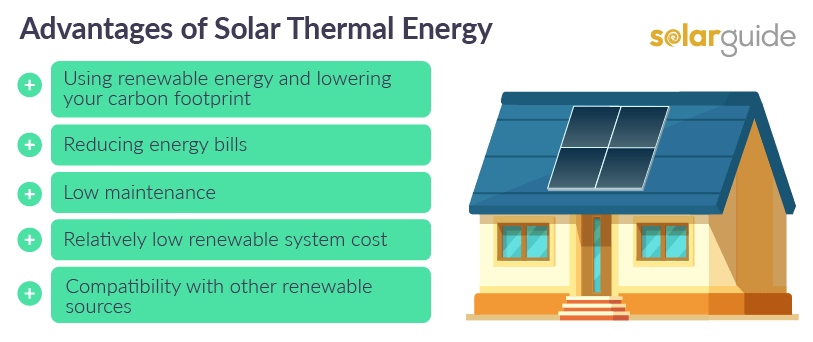
- Using renewable energy and lowering your carbon footprint: Did you know that 88% of domestic hot water comes directly from gas and oil? Only 2% is generated from renewable energy sources despite the long-term environmental and financial benefits. You can reduce your home’s reliance on fossil fuels and lower your carbon footprint by almost 3,000kg of CO2 every year when switching to solar thermal from a gas boiler.
- Reducing energy bills: Solar thermal heating systems can significantly reduce energy consumption, leading up to £240 in savings on annual energy bills. Compared to traditional heating methods that rely heavily on gas and oil, solar thermal systems are more cost-effective in the long run.
- Low maintenance: Once installed, solar thermal systems generally require minimal maintenance, unlike systems that use fossil fuels like coal or natural gas. This means fewer ongoing expenses and less hassle.
- Relatively low renewable system cost: With an average price range of £3,000 to £7,000, solar thermal systems have a relatively low upfront cost compared to other renewable systems. For comparison, air source heat pump costs range between £5,000 – £18,000 and a solar PV system ranges between £5,000 – £11,000.
- Compatibility with other renewable sources: Solar thermal energy can be used in conjunction with other renewable energy sources like biomass and geothermal systems. It can also complement existing gas boilers, offering flexibility and versatility in meeting your heating needs.
Disadvantages of solar thermal energy
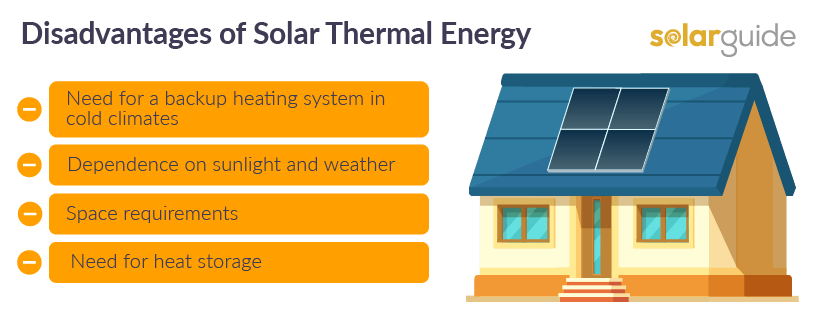
- Need for a backup heating system in cold climates: Solar thermal systems may require a backup heating system, such as a gas boiler, in colder climates like the UK. This backup is needed when solar energy alone cannot provide sufficient heating.
- Dependence on sunlight and weather: Solar thermal collectors rely on sunlight to generate heat. They may not perform optimally or consistently in areas with limited sunlight or during cloudy periods. Their effectiveness is closely tied to weather conditions and the time of day.
- Space requirements: Solar thermal collectors require a certain amount of space and specific orientation to be effective. This may limit their applicability in some building types or locations where space is limited or not appropriately oriented to capture sunlight efficiently.
- Need for heat storage: Solar thermal systems collect the most energy during the day when solar irradiance is abundant. However, this isn’t optimal for homes that use a lot of hot water during the day unless there is storage. Often additional storage systems are required to store excess heat energy generated during the day. Without adequate storage, this excess energy may go to waste.
Thinking about using solar thermal systems to heat your home? We recommend all homeowners to reach out to multiple professional solar panel installers for quotes. They can help you understand how solar thermal works for your home, including its benefits and drawbacks. With their expertise, you’ll get a clear picture of how solar thermal can save you money and reduce your reliance on traditional energy sources.
Start your solar thermal journey by clicking the link below.
Get Free Solar Thermal Panel Quotes: Get quotes and compare prices.
How many solar thermal panels do you need?
The number of solar thermal collectors you need depends on your daily hot water load. While an experienced installer can provide a more accurate estimate based on your specific usage patterns, here’s a general guideline to help you get started.
Solar thermal collectors are a sustainable way to generate hot water, but it’s important to understand that they may not fully meet all your hot water needs. On average, a well-designed solar thermal system can provide up to 60% of a home’s domestic hot water demands.
In the United Kingdom, an average 4-person household typically uses around 122 litres of hot water per day. This translates to each individual using between 30 and 50 litres of hot water daily. However, solar thermal collectors only generate heat when the sun is shining during the day. To ensure you have hot water available in the early morning or at night, a storage tank is required.
It’s worth noting that larger storage tanks can result in greater heat losses and higher maintenance costs. Therefore, finding the right balance between collector area and storage tank size is crucial for maximising solar gain while adhering to economic, efficiency, and durability constraints.
To provide a rough estimate, here’s a table indicating the number of collectors and space required based on the size of your household:
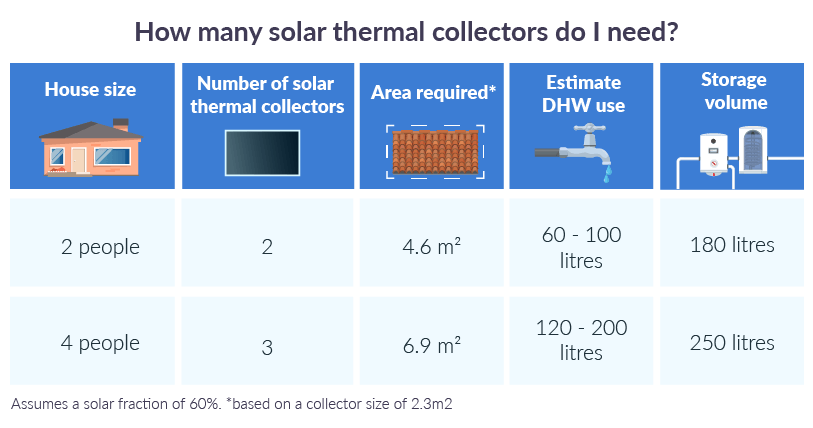
Keep in mind that these are rough estimates, and actual requirements may vary based on several factors such as climate, the efficiency of your solar thermal system, and your desired hot water temperature.
In conclusion, determining how many solar thermal collectors you need involves assessing your household’s hot water load, collector efficiency, and daily usage patterns. Consulting with a knowledgeable installer and considering the provided table can help you make an informed decision, ensuring that your solar thermal system meets your hot water needs efficiently and effectively.
Solar thermal installation: What is involved?
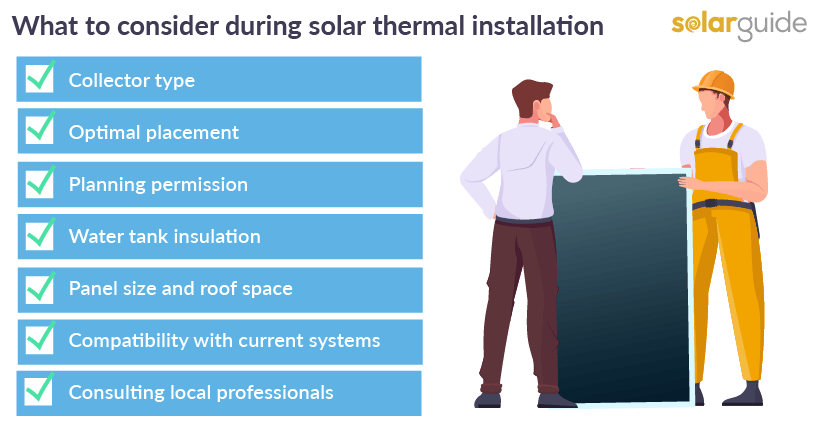
A solar thermal installation involves several key considerations to ensure maximum efficiency and effectiveness. Here’s a brief overview of the most important factors to consider:
Components of a solar thermal system: A solar thermal system consists of four primary components:
- Solar thermal collectors
- Storage tank
- Solar loop
- Control system
Optimal placement: For maximum solar panel efficiency, it’s important to install the panels on south-facing roofs, ideally between SE and SW directions. The panels should be positioned at an angle of approximately 30-50 degrees and free from any shading caused by trees, chimneys, or nearby buildings.
Planning permission: In some cases, you may require planning permission for solar thermal panel installation, particularly if your property is located in a conservation area or is a listed building. It’s advisable to consult your local planning office or a local installer.
Water tank insulation: Prior to installing a solar thermal system, it’s essential to ensure that your property is adequately insulated. Proper insulation plays a crucial role in maximising the effectiveness of the system and enhancing energy savings.
Panel size: A typical domestic installation usually requires an area of 3 – 5 square metres for the solar panels. While south-facing placement is optimal, panels facing east or west can still be effective.
Compatibility: Solar thermal systems can typically be integrated into most existing hot-water systems.
It may be necessary to replace your current hot water cylinder with one featuring a twin coil to ensure compatibility.
Combining a solar thermal system with a combi boiler can be challenging due to the boiler’s direct mains water supply heating. However, some newer combi boilers may accept pre-heated water. You can ask advice from your solar thermal installer.
Collector types: Evacuated tubes are an option but tend to be more expensive compared to glazed flat plate collectors. Some evacuated tubes cannot be installed integral to the roof. In contrast, flat plate collectors offer flexibility in installation and can be integrated with the roof, mounted on it, or even facade-mounted.
Consult a solar professional: Lastly, it’s crucial to emphasise the importance of consulting a solar professional for advice, prices, and other important information specific to your home. Every property is unique, and a solar expert can assess your individual needs, ensuring that your solar thermal system is tailored for optimal performance and energy savings.
Find solar thermal installers for your UK household
When considering the installation of a solar thermal system for your UK household, one of the most crucial steps is answering the question “how do I find solar thermal installers near me?”. Working with professionals who understand the intricacies of solar thermal technology and how to optimise it for your local area is vital to ensure the system’s efficiency and longevity. They’ll help answer your questions and address any concerns you may have.
Finding and vetting local solar thermal installers doesn’t need to involve long and painstaking hours on the phone or online researching. With Solar Guide, homeowners can easily find up to 4 certified solar thermal installers through our network of partnered installers. We’ll connect you with installers who have the necessary expertise to assess your property, provide tailored quotes, and carry out the installation seamlessly so that you’re maximising your financial and carbon savings.
All the quotes you receive from these installers come at no cost to you and come with no obligation to accept. You only accept offers that match your budget and preference. So you have nothing to lose and savings to gain.
This easy and free process all starts with a 30-second contact form by clicking the link below.
Get Free Solar Thermal Panel Quotes: Get quotes and compare prices.
FAQ
Is solar thermal any good?
Solar thermal can be an excellent choice for heating water in homes and businesses, as it harnesses the sun’s energy to provide an eco-friendly and cost-effective source of hot water.
What does solar thermal do?
Solar thermal systems are a popular water heating option that captures sunlight to convert to heat energy that can be used to provide hot water for domestic or commercial uses. Many homeowners in the UK have found them to offer many advantages and fewer drawbacks.
How much does it cost to install solar thermal?
The cost of installing a solar thermal system can vary widely based on factors like system size, location, and any necessary modifications to existing systems. On average, solar thermal installation costs in the UK can range from £3,000 to £7,000 or more.
Is solar thermal better than solar panels?
Solar thermal and solar photovoltaic (PV) panels serve different purposes. Solar thermal systems heat water, while solar panels generate electricity. The choice between the two depends on your specific energy needs.
Is solar thermal heating expensive?
Solar thermal heating can provide long-term savings on energy bills, but the initial installation cost can be relatively high. However, over time, the system can pay for itself through reduced energy expenses.
Can you install solar thermal yourself?
While it’s technically possible to install a solar thermal system yourself, it’s a complex task that requires knowledge of plumbing, electrical work, and safety regulations. It’s generally recommended to hire a qualified installer to ensure proper installation and compliance with local codes and safety standards.
Find local, MSC certified Solar Installers
Start your quote
Find local, MSC certified Solar Installers






